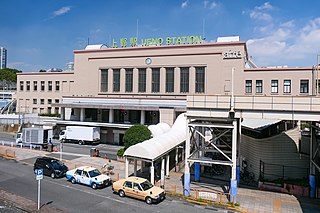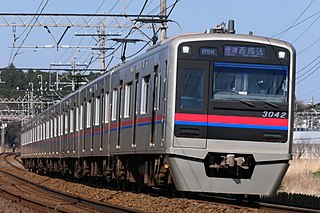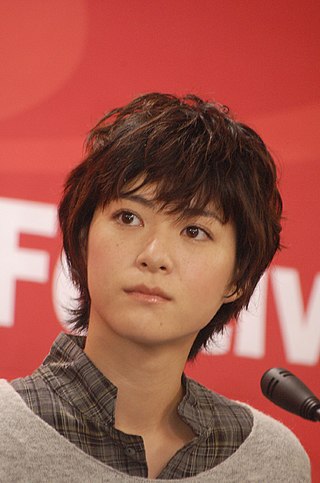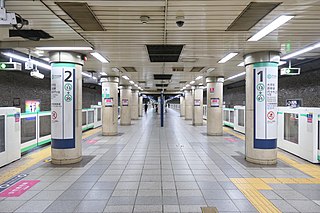Related Research Articles

Taitō is a special ward located in Tokyo Metropolis, Japan. In English, it is known as Taitō City.

Ueno Station is a major railway station in Tokyo's Taitō ward. It is the station used to reach the Ueno district and Ueno Park—which contains Tokyo National Museum, The National Museum of Western Art, Ueno Zoo, Tokyo University of the Arts and other famous cultural facilities. A major commuter hub, it is also the traditional terminus for long-distance trains from northern Japan, although with the extension of the Shinkansen lines to Tokyo Station this role has diminished in recent years. A similar extension of conventional lines extended Takasaki Line, Utsunomiya Line and Jōban Line services to Tokyo Station via the Ueno-Tokyo Line in March 2015, using existing little-used tracks and a new viaduct; the Ueno-Tokyo Line connects these lines with the Tōkaidō Main Line, allowing through services to Shinagawa, Yokohama, Odawara and Atami stations.

Hachikō was a Japanese Akita dog remembered for his remarkable loyalty to his owner, Hidesaburō Ueno, for whom he continued to wait for over nine years following Ueno's death.

Ueno (上野) is a district in Tokyo's Taitō Ward, best known as the home of Ueno Park. Ueno is also home to some of Tokyo's finest cultural sites, including the Tokyo National Museum, the National Museum of Western Art, and the National Museum of Nature and Science, as well as a major public concert hall. Many Buddhist temples are in the area, including the Bentendo temple dedicated to goddess Benzaiten, on an island in Shinobazu Pond. The Kan'ei-ji, a major temple of the Tokugawa shōguns, stood in this area, and its pagoda is now within the grounds of the Ueno Zoo. Nearby is the Ueno Tōshō-gū, a Shinto shrine dedicated to Tokugawa Ieyasu. Near the Tokyo National Museum there is The International Library of Children's Literature. Just south of the station is the Ameya-yokochō, a street market district that evolved out of an open-air black market that sprung up after World War II. Just east is the Ueno motorcycle district, with English-speaking staff available in some stores.

The Utsunomiya Line is the name given to a 163.5-kilometer (101.6 mi) section of the Tōhoku Main Line between Tokyo Station in Tokyo and Kuroiso Station in Nasushiobara, Tochigi, Japan. It is part of the East Japan Railway Company network.

The Ueno Zoo Monorail Line is a 0.3 km (0.19 mi) long suspended railway operated by the Tokyo Metropolitan Bureau of Transportation (Toei). It lies within the Ueno Zoo in Taitō, Tokyo, Japan. The monorail is similar to the Wuppertal Schwebebahn, but has rubber tires rather than steel wheels. Many of the parts manufactured for the monorail were off-the-shelf. The first monorail in the nation, it has two stations, single track, and operates at 600 V DC. The line began operating on December 17, 1957, was suspended during 2001–2002, and has been suspended since October 31, 2019, with the operator citing the high costs of replacing the aging trains. Being located inside the zoo, it only operated on days when the zoo was open, and between 9:40 a.m. and 4:30 p.m., with departures scheduled every seven minutes. The fare for the 90-second trip was 150 yen.

The Jōban Line is a railway line in Japan operated by the East Japan Railway Company. The line officially begins at Nippori Station in Arakawa, Tokyo before the line officially ends at Iwanuma Station in Iwanuma, Miyagi. However, following the opening of the Ueno–Tokyo Line, Jōban Line train services originate at Shinagawa or Ueno; likewise, Jōban Line trains continue past Iwanuma onto the Tōhoku Main Line tracks to Sendai. The line approximately parallels the Pacific coasts of Chiba, Ibaraki, and Fukushima Prefectures.

The Keisei Main Line is a railway line of Japanese private railway company Keisei Electric Railway connecting Tokyo and Narita, Japan. It is the main line of Keisei's railway network. Built as an interurban between Tokyo and Narita in the early 20th century, the line has been serving as a main access route to Narita International Airport since 1978. It also serves major cities along the line such as Funabashi, Narashino, and Sakura.

Juri Ueno is a Japanese actress. She first gained recognition in the 2005 film Swing Girls where she was a recipient of Newcomer of the Year prize at the Japanese Academy Awards. Ueno achieved mainstream success for playing the titular role in the live-action adaptations of manga Nodame Cantabile for which she won Best Lead Actress at the 51st Television Drama Academy Awards in 2007. She further gained acclaim with her role in the television series Last Friends for which she won Best Supporting Actress at the Nikkan Sports Drama Grand Prix and the 57th Television Drama Academy Awards in 2008.

Yushima Station is a subway station on the Tokyo Metro Chiyoda Line in the Bunkyo-ku, Tokyo, Japan, operated by the Tokyo subway operator Tokyo Metro. It is located near Shinobazu Pond and Ueno Park.
Kōji Ueno is a Japanese composer, musician, arranger and keyboardist. He is noted for his unique style of music.
The Chushikoku Open is a golf tournament which was on the Japan Golf Tour from 1973 to 1991. It was first played in 1971. The event is usually held in September at a variety of courses in Southern Honshu and on Shikoku island.

Ling Ling was a male Chinese-born giant panda who resided at the Ueno Zoo, the largest zoo in Tokyo, Japan. At the time of his death at the age of 22, Ling Ling was the only giant panda at the Ueno Zoo and the oldest panda in Japan. He served as an important symbol of the Ueno Zoo and of friendship between Japan and China. Ling Ling, who was given to Japan in 1992, was the only giant panda in the country who was directly owned by Japan. There are eight other giant pandas in Japan as of April 2008, but they are all on loan to Japan from China. Despite being a male panda, Ling Ling's name meant "darling little girl" in Chinese.

The Ueno–Tokyo Line, formerly known as the Tōhoku Through Line is a railway line in Tokyo, Japan, operated by the East Japan Railway Company, linking Ueno Station and Tokyo Station, extending the services of the Utsunomiya Line, the Takasaki Line, and the Jōban Line southward and onto the Tōkaidō Main Line and vice versa. The project began in May 2008. The line opened with the 14 March 2015 timetable revision, with the project costing about JPY 40 billion.
Ryugadous is a genus of beetles in the family Carabidae, containing the following species:
Stygiotrechus is a genus of beetles in the family Carabidae, containing the following species:

The Soyokaze (そよかぜ) was a limited express train service in Japan introduced by Japanese National Railways (JNR) in July 1968, and later operated by the East Japan Railway Company between Ueno in Tokyo and Naka-Karuizawa on the Shinetsu Main Line in Nagano Prefecture.

Trechini is a large tribe of ground beetles in the family Carabidae. There are more than 270 genera and over 2,400 described species in Trechini, found throughout the world.
Hirokazu Ueno is a Japanese professional shogi player ranked 6-dan.
The Ueno Route, signed as Route 1, is one of the tolled routes of the Shuto Expressway system serving the Greater Tokyo Area. It is one two expressways signed as Route 1 in the system, the other expressway signed as Route 1 is the Haneda Route. The route is a 4.4-kilometer (2.7 mi) long radial highway running northeast from the ward of Chūō in central Tokyo to the ward of Taitō. It connects Tokyo's Inner Circular Route in central Tokyo to the Ueno area and Ueno Station, a major rail hub, and National Route 4, which connects the Kantō region to the Tōhoku region.
References
- ↑ "Coreoblemus Ueno, 1969". Catalogue of Life. Retrieved 2023-04-09.